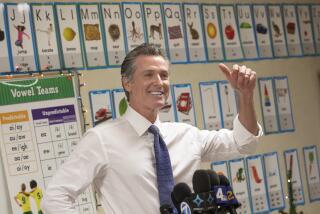High Schools Are 1.0 in a 5.0 World, Gates Says
WASHINGTON — Addressing the nation’s governors, Microsoft co-founder Bill Gates delivered a scathing critique of U.S. high schools Saturday, calling them obsolete and saying that elected officials should be ashamed of a system that leaves millions of students unprepared for college and for technical jobs.
Gates was speaking as the invited guest of some of the nation’s most powerful elected officials, at a National Governors Assn. meeting devoted to improving high school education across the country.
“Training the workforce of tomorrow with today’s high schools is like trying to teach kids about today’s computers on a 50-year-old mainframe,” said Gates, whose $27-billion Bill and Melinda Gates Foundation has made education one of its priorities.
“Everyone who understands the importance of education, everyone who believes in equal opportunity, everyone who has been elected to uphold the obligations of public office should be ashamed that we are breaking our promises of a free education for millions of students,” added Gates, to strong applause.
Virginia Gov. Mark R. Warner, chairman of the nonpartisan association, said high school education was in need of an overhaul to raise standards and to closely align instruction with the requirements of colleges and employers.
“It is imperative that we make reform of the American high school a national priority,” Warner, a Democrat, said.
The governors’ winter meeting coincides with a push by President Bush to extend elements of his No Child Left Behind initiative from the primary grades to the high school level.
The governors painted a dire picture of the state of public high schools, releasing statistics that, according to the National Center for Public Policy and Higher Education, showed 68% of ninth-graders graduate from high school on time.
But, measuring a different way, U.S. government statistics show steady increases in high school graduation rates, particularly among whites and African Americans, although less so for Latinos.
For example, the high school graduation rate for adults 25 years or older was at an all-time high of 85% in 2003, as was the 27% share of adults holding at least a bachelor’s degree.
Behind the national numbers, there is general agreement that wide disparities exist among high schools and that geography, income, race and ethnicity affect the value of a diploma.
“Only a fraction of our kids are getting the best education,” Gates said. “Once we realize that we are keeping low-income and minority kids out of the rigorous courses, there can only be two arguments for keeping it that way: Either we think they can’t learn, or we think they’re not worth teaching.
“The first argument would be factually wrong. The second would be morally wrong.”
Gates said his foundation had contributed about $1 billion to improve the quality of U.S. education and was supporting reforms at more than 1,500 high schools.
His involvement began with a college scholarship program for minority students. But then he and his wife realized many of the students they were sponsoring did not have the academic skills to survive in college.
“The more we looked at the data, the more we came to see that there is more than one barrier to college,” Gates said. “There’s the barrier of not being able to pay for college, but there’s the barrier of not being prepared for college.”
Gates called for a new design for American high schools, based on smaller schools with higher standards for math and language proficiency, instruction that is relevant to students’ goals in life and better support from teachers and counselors.
He also called for a get-tough approach toward schools that fail.
“When the students don’t learn, the school must change,” Gates said. “Every state needs a strong intervention strategy to improve struggling schools.”
“This needs to include special teams of experts who are given the power and resources to turn things around,” he said.
More to Read
Sign up for Essential California
The most important California stories and recommendations in your inbox every morning.
You may occasionally receive promotional content from the Los Angeles Times.










